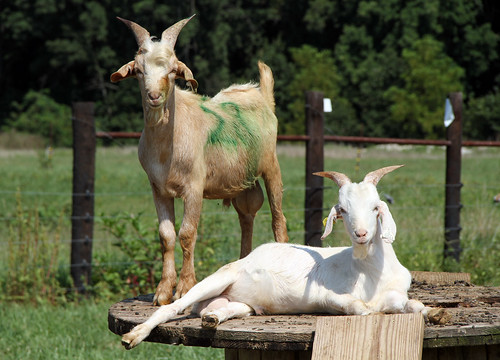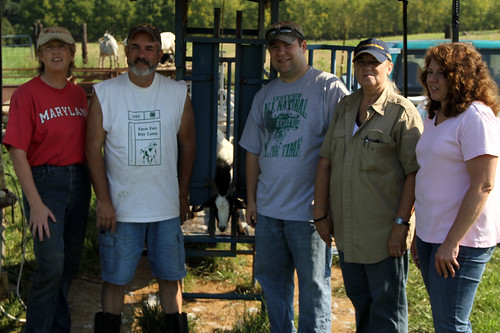The goats must experience a significant parasite challenge in order for there to be separation between resistant and susceptible bucks and resilient and non-resilient bucks. This is now occurring. FAMACHA© scores continued to worsen and 18 goats (38%) required deworming.
FAMACHA© scores ranged from 1 to 5 and averaged 2.77 ± 0.95, compared to 2.08 two weeks ago. The median FAMACHA© score was 2, as only one goat had a FAMACHA© score of 1. Fortunately, only one goat had a FAMACHA© score of 5. There were many goats with FAMACHA© scores of 3 or 4.
The dosing of the goats with worm larvae in June is not likely the cause of the emerging parasite problem, as 7 of the 15 "pasture" goats in the pen vs. pasture study also required deworming (and they were not dosed with the larvae). Along with the mild winter, this summer's warm, moist conditions are ideal for development of the barber pole worm. Unlike the previous several years, this year's test has not experienced any dry spells.
Goats with FAMACHA© scores of 4 and 5 were dewormed, as recommended by the FAMACHA© card. The decision to deworm goats with FAMACHA© scores of 3 was based on additional criteria, such as rate of gain, body condition, and fecal egg count (on August 9). Clinically parasitized goats were dewormed orally with moxidectin (Cydectin @ 2 ml/11 lbs.).
Clinical parasitism (of some) and sub-clinical parasitism (of others) is probably to blame for the lack of gain. Gain ranged from -6 to 4 lbs. and averaged 0.52 ± 2.31 lbs. during the past 13 days. Average daily gained ranged from -0.462 to 0.308 lbs. per day and averaged 0.04 ± 0.18 lbs. per day. There were four bucks that gained 4 lbs. or 0.308 lbs. per day. These included a buck consigned by Kendall and Dana Barnes (KY), two bucks consigned by Sam Burke (DE), and a buck consigned by Dee & David Richhart (IN).
For the first 70 days of the test, average daily gain (ADG) is ranging from -0.043 to 0.312 lbs. per day and is averaging 0.159 ± 0.075 lbs. per day. The median gain is 0.167 lbs. per day. As of d-70, the top gaining buck remains #43, a Purebred Kiko consigned by Jill Zink (IN). #29, a Boer x Kiko consigned by Randy & Jody Majancsik (KY) has the second highest rate-of-gain at 0.297 lbs. per day. The third best gaining buck is #9, a New Zealand Kiko consigned by Sam Burke. It is gaining 0.246 lbs. per day.
There was a slight decline in body condition scores, from 2.42 to 2.26. This is consistent with the lack of gain. Coat condition stayed the same and averaged 2.1. No goat had a positive dag score. No goat had active scours (diarrhea).
The goats were worked today by Jeff Semler, David Gordon, Mary Beth Bennett, Susan Schoenian, and Pam Thomas. Jeff weighed the goats and David recorded weights. Susan scored the goats and Pam recorded data. Jim Pritchard from West Virginia University scanned the goats to determine rib eye area. The scans will be sent to an ultrasound processing lab for analysis.
To prevent potential losses from worms, FAMACHA© scores will be re-checked in a week. Final data will be collected on September 6. A final fecal sample will be collected and the analysis will be expedited for inclusion in the data set. September 6 is also the day that the goats will be evaluated for reproductive soundness (teats and testicles) and structure correctness (teeth, structure, and hooves).
Pasture conditions remain good. There is ample forage of good quality and variety. The bucks are not in full rut. Hopefully, by ending the test two weeks earlier, rutting behavior will not have much influence on gain potential.
Download August 22 (d-70) report
FAMACHA© scores ranged from 1 to 5 and averaged 2.77 ± 0.95, compared to 2.08 two weeks ago. The median FAMACHA© score was 2, as only one goat had a FAMACHA© score of 1. Fortunately, only one goat had a FAMACHA© score of 5. There were many goats with FAMACHA© scores of 3 or 4.
 |
| Several goats had FAMACHA© scores of 4. Image by Pam Thomas |
The dosing of the goats with worm larvae in June is not likely the cause of the emerging parasite problem, as 7 of the 15 "pasture" goats in the pen vs. pasture study also required deworming (and they were not dosed with the larvae). Along with the mild winter, this summer's warm, moist conditions are ideal for development of the barber pole worm. Unlike the previous several years, this year's test has not experienced any dry spells.
Goats with FAMACHA© scores of 4 and 5 were dewormed, as recommended by the FAMACHA© card. The decision to deworm goats with FAMACHA© scores of 3 was based on additional criteria, such as rate of gain, body condition, and fecal egg count (on August 9). Clinically parasitized goats were dewormed orally with moxidectin (Cydectin @ 2 ml/11 lbs.).
 |
| The bucks enjoy being on the spool. |
Clinical parasitism (of some) and sub-clinical parasitism (of others) is probably to blame for the lack of gain. Gain ranged from -6 to 4 lbs. and averaged 0.52 ± 2.31 lbs. during the past 13 days. Average daily gained ranged from -0.462 to 0.308 lbs. per day and averaged 0.04 ± 0.18 lbs. per day. There were four bucks that gained 4 lbs. or 0.308 lbs. per day. These included a buck consigned by Kendall and Dana Barnes (KY), two bucks consigned by Sam Burke (DE), and a buck consigned by Dee & David Richhart (IN).
For the first 70 days of the test, average daily gain (ADG) is ranging from -0.043 to 0.312 lbs. per day and is averaging 0.159 ± 0.075 lbs. per day. The median gain is 0.167 lbs. per day. As of d-70, the top gaining buck remains #43, a Purebred Kiko consigned by Jill Zink (IN). #29, a Boer x Kiko consigned by Randy & Jody Majancsik (KY) has the second highest rate-of-gain at 0.297 lbs. per day. The third best gaining buck is #9, a New Zealand Kiko consigned by Sam Burke. It is gaining 0.246 lbs. per day.
 |
| Forage variety |
There was a slight decline in body condition scores, from 2.42 to 2.26. This is consistent with the lack of gain. Coat condition stayed the same and averaged 2.1. No goat had a positive dag score. No goat had active scours (diarrhea).
The goats were worked today by Jeff Semler, David Gordon, Mary Beth Bennett, Susan Schoenian, and Pam Thomas. Jeff weighed the goats and David recorded weights. Susan scored the goats and Pam recorded data. Jim Pritchard from West Virginia University scanned the goats to determine rib eye area. The scans will be sent to an ultrasound processing lab for analysis.
 |
| The "Goat Team" (L-R) Schoenian, Semler, Gordon, Bennett, Thomas |
To prevent potential losses from worms, FAMACHA© scores will be re-checked in a week. Final data will be collected on September 6. A final fecal sample will be collected and the analysis will be expedited for inclusion in the data set. September 6 is also the day that the goats will be evaluated for reproductive soundness (teats and testicles) and structure correctness (teeth, structure, and hooves).
Pasture conditions remain good. There is ample forage of good quality and variety. The bucks are not in full rut. Hopefully, by ending the test two weeks earlier, rutting behavior will not have much influence on gain potential.
Download August 22 (d-70) report











